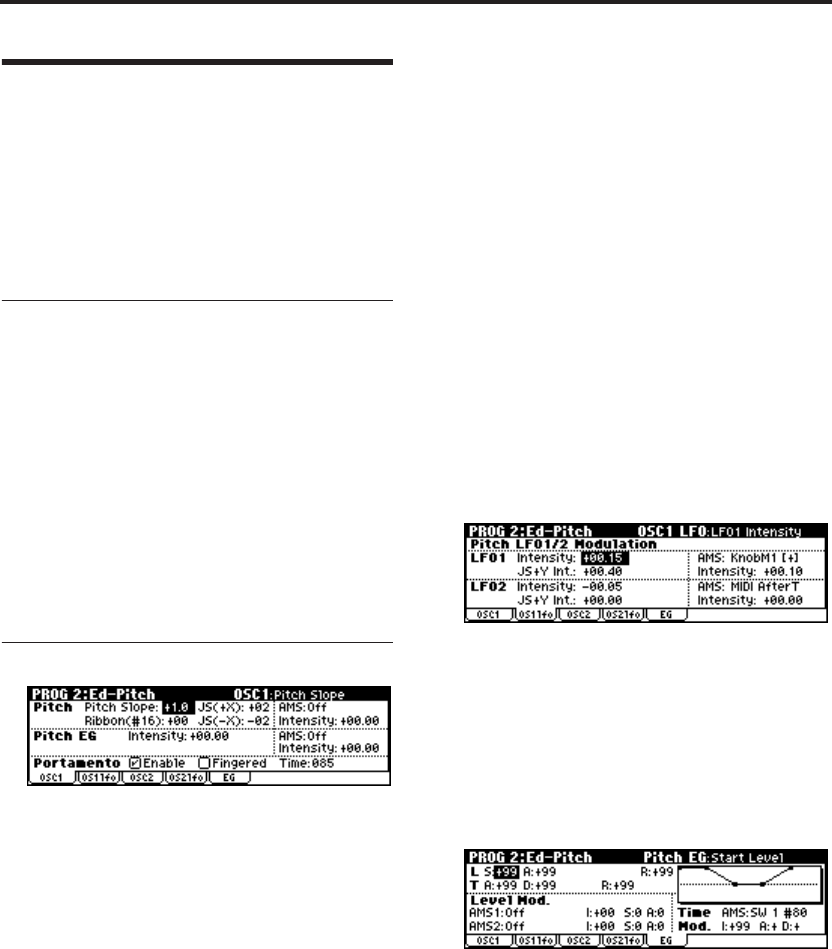
Playing and Editing Programs
52
Controlling Pitch
Here you can specify how the pitch of the multi-
sample selected for the oscillator will change.
Pitch EG and LFO settings allow the pitch to var-
ied over time.
Note: To specify the basic pitch of the multisample,
use the “Octave” parameter in the PROG 1: Ed–
Basic, OSC1 or OSC2 page.
Varying the pitch according to key-
board position (Pitch Slope)
On keyboard instruments such as piano or organ,
the pitch will rise as you play toward the right
side of the keyboard, and fall as you play toward
the left.
You can use the “Pitch Slope” setting to specify
how this will occur.
With positive (+) settings, the pitch will rise as you
play toward the right side of the keyboard. With
negative (–) settings, the pitch will fall as you play
toward the right side of the keyboard.
Normally you will leave this set to +1.0.
Modulating the pitch
Pitch bend
The JS (+X) and JS(–X) settings specify the
amount of pitch change (in semitones) that will
occur when MIDI pitch bend messages are
received or when the joystick is moved to left or
right. A setting of +12 allows the pitch to be con-
trolled a maximum of one octave upward; a set-
ting of –12 allows the pitch to be controlled a
maximum of one octave downward.
“Ribbon (#16)” specifies the amount of pitch
change (in units of a semitone) that will occur
when CC#16 is received (or when you operate the
ribbon controller of a connected TRITON Extreme
or similar device).
Portamento
Portamento makes the pitch change smoothly
when you play the next note before releasing the
previous note.
The “Time” parameter controls how long it take
the pitch to change. As this value is increased, the
pitch will change over a longer time. With a value
of 000, there will be no portamento.
Creating Vibrato
You can use an LFO to create vibrato.
LFO 1/2 Intensity sets the depth to which the
selected LFO will affect the pitch. With a setting of
+12.00, vibrato will produce a maximum of ±1
octave of pitch change.
“JS+Y Int” specifies the amount of vibrato that the
LFO will produce when the joystick is pushed
away from yourself.
“AMS Intensity” specifies the depth of the vibrato
effect created by LFO when you operate an AMS
(Alternate Modulation Source). For example, sup-
pose you set “LFO1 AMS” to KnobM1 [+] (Knob
Mod1: CC#17), and raise the “AMS Intensity.” If
Knob B Assign “Knob 1-B” is set to Knob Mod.1
(CC#17), vibrato will be applied when you turn
the microX’s knob [1] or when CC#17 is received.
Pitch EG
When the Intensity value is set to +12.00, the pitch
EG specified in the Pitch EG page will produce a
maximum of ±1 octave of pitch change.
To realistically simulate the slight change in pitch
that occurs when a string is plucked or at the
attack of a brass or vocal sound, you can use the
EG to create a subtle change in pitch at the attack.


















